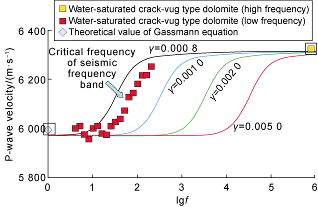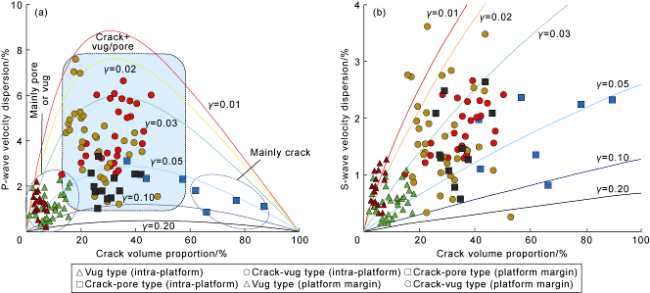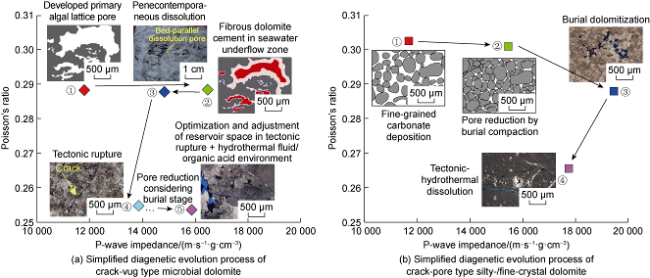The reservoirs of platform margin and restricted platform subfacies are similar in diagenetic evolution, and the reservoirs of platform margin and intra-platform mound-shoal microfacies are deposited in geomorphic highlands (
Fig. 2c), where strong hydrodynamic conditions and abundant nutrient components promoted the rapid growth of microorganisms such as blue-green algae (bacteria). Extracellular polymers produced by microbial activities led to low-temperature dolomite precipitation
[5,25], forming microbial dolomites such as algal-stromatolitic dolomite and algal-laminated dolomite, which evolved into vertically stacked multi-stage mound-shoal complexes with uplifted landform due to periodic sea level fluctuations. These microbial dolomites have well-developed algal lattice pores and intergranular pores. During the same period, foliated dolomite formed by early low-temperature dolomitization processes such as evaporative seepage-reflux, and capillary concentration filled the primary pores. After this diagenetic stage, the sediments were basically consolidated, and the reservoir space was mainly composed of residual algal lattice pores and intergranular pores. Due to frequent and continuous exposure to the sea surface, the early low-temperature dolomite (with low degree of ordering), and incompletely consolidated and dolomitized easily soluble minerals (e.g. calcareous minerals and aragonite) were dissolved by atmospheric fresh water during penecontemporaneous dissolution. Dissolved vugs are distributed along beds in the cores (
Fig. 4a), and mostly filled with bitumen. Affected by the differential uplift of Episode II of Tongwan Movement, severe uplift-induced erosion occurred within the platform in central Sichuan Basin, and a certain scale of karst fractures and vugs were formed during the late stage of epigenetic karstification, which had a limited influence on northern Sichuan Basin. As the strata subsided, muddy-crystal dolomite underwent recrystallization and secondary enlargement due to burial dolomitization, and some clastic or microbial dolomites formed fine- to medium-crystal dolomites without residual original rock fabric, or silty-/fine-crystal dolomites with residual original rock fabric. During this period, the fault system formed by multiple tectonic ruptures in the reservoir, providing a pathway for the activity of organic acids generated by basement hydrothermal fluids and the cracking of the Qiongzhusi Formation source rock. In such a closed system, the products of hydrothermal fluid or organic acid dissolution could not flow out, and the formed precipitates, such as saddle dolomite, pyrite and quartz, would damage pores. The reservoir space remained stable as a whole. Burial dissolution could adjust the pore system. And the areas with better porosity and permeability (where acidic fluids are more likely to flow in) have a large specific surface area of dissolution and more developed dissolution pores, thereby optimizing the distribution of reservoir spaces. The difference between the platform margin mound-shoal and the intra-platform mound-shoal mainly lies in the scale of the mound-shoal complexes and the intensity of penecontemporaneous dissolution. The former was deposited under stronger hydrodynamic conditions, resulting in larger mound-shoal complex, longer exposure time to the sea surface, and stronger penecontemporaneous dissolution. The latter, distributed in relatively high positions within restricted platforms, was deposited under weaker hydrodynamic conditions, resulting in mound-shoal complexes with smaller vertical scale and horizontal range, and weaker penecontemporaneous dissolution.













